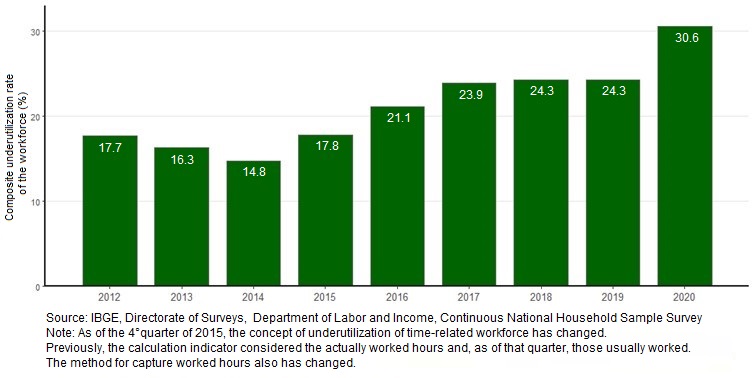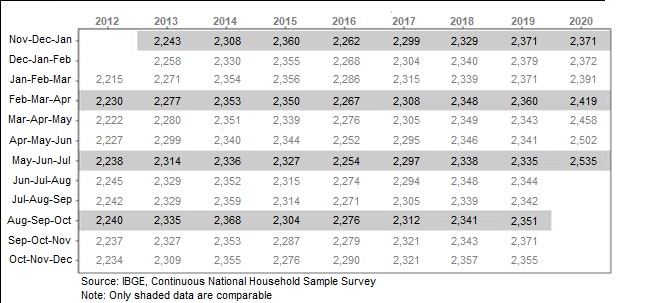Continuous PNAD: unemployment rate is 14.4%, underutilization rate is 30.6% in quarter ending in August 2020
October 30, 2020 09h00 AM | Last Updated: November 06, 2020 03h13 PM
The unemployment rate (14.4%) in the quarter from June to August 2020 was the highest one in the time series started in 2012, increasing 1.6 percentage points (p.p.) in relation to the quarter between March and May (12.9%) and 2.6 p.p. over the quarter from June to August 2019 (11.8%).
| Indicator / Period | Jun-Jul-Aug 2020 | Mar-Apr-May 2020 | Jun-Jul-Aug 2019 |
|---|---|---|---|
| Unemployment rate | 14.4% | 12.9% | 11.8% |
| Underutilization rate | 30.6% | 27.5% | 24.3% |
| Usual real earnings (R$) | 2,542 | 2,465 | 2,351 |
| Change of the usual real earnings in relation to: | 3.1% | 8.1% | |
|
Change of the usual real earnings in relation to: |
3.1% |
8.1% |
The unemployed population (13.8 million persons) rose 8.5% (more 1.1 million persons) over the previous moving quarter (12.7 million) and increased 9.8% (more 1.2 million persons) in relation to the sale quarter of 2019 (12.6 million).
The employed population (81.7 million, the smallest in the time series) fell 5.0% (less 4.3 million persons) in relation to the previous quarter and 12.8% (less 12.0 million persons) over the same quarter of 2019. The employment-population ratio (46.8%) was also the lowest one in the time series, dropping 2.7 p.p. over the previous quarter and 7.9 p.p. over the same quarter of 2019.
The composite underutilization rate (30.6%) was a record in the time series, increasing 3.1 p.p. in relation to the previous moving quarter (27.5%) and 6.2 p.p. over the same quarter of 2019 (24.3%). The underutilized population (33.3 million persons) was also a record, rising 9.7% (more 3.0 million persons) over the previous quarter and 20.0% (more 5.6 million persons) over the same quarter of 2019.
The population in the workforce (95.5 million persons) fell 3.2% (less 3.2 million) over the previous quarter and 10.1% (less 10.7 million persons) in relation to the same quarter of 2019. The population out of the workforce (79.1 million persons) was a record in the time series, rising 5.6% (more 4.2 million persons) in relation to the previous quarter and 21.9% (more 14.2 million persons) over the same quarter of 2019.
The discouraged population (5.9 million) was a record, with rises of 8.1% (more 440 thousand persons) in relation to the previous quarter and of 24.2% (more 1.1 million persons) over the same quarter of 2019. The percentage of discouraged in relation to the population in the workforce or discouraged (5.8%) was also a record, increasing 0.6 p.p. over the previous quarter and 1.5 p.p. over the same quarter of 2019.
Estimated at 29.1 million, the number of persons employed with a formal contract in the private sector (excluding domestic workers) was the lowest one in the time series, dropping 6.5% (less 2.0 million persons) over the previous quarter and 12.0% (less 4.0 million persons) over the same quarter of 2019. The number of persons employed without a formal contract in the private sector (8.8 million persons) fell 5.0% (less 463 thousand persons) in relation to the previous moving quarter and 25.8% (less 3.0 million) over the same quarter of 2019. The number of self-employed workers (21.5 million persons) dropped in both comparisons: -4.0% (or less 894 thousand) over the previous moving quarter and -11.4% (or less 2.8 million persons) over the same period of 2019.
The number of domestic workers (4.6 million persons) was the lowest one in the time series, dropping 9.4% (less 473 thousand persons) over the previous quarter and 27.5% (less 1.7 million persons) over the same quarter of 2019.
The informality rate hit 38.0% of the employed population (or 31.0 million informal workers). The rate had been 37.6% in the previous quarter and 41.4% in the same quarter of 2019.
The average usual real earnings (R$2,542) in the quarter ended in August rose 3.1% over the previous quarter and 8.1% in relation to the same quarter of 2019. The usual real wage bill (R$202.5 billion) fell 2.2% (less R$4.6 billion) over the previous quarter and 5.7% (less R$12.3 billion) over the same quarter of 2019.

Although the moving quarter from June to August 2020 registered the smallest contingent of employed population (81.7 million persons) in the time series, the pace of drop of this population decelerated in relation to the retraction occurred in the quarter ended in May 2020.
The population out of the workforce (79.1 million) also hit its highest value in the time series, resulting in a growth of 14.2% in the potential workforce in relation to the previous moving quarter. In spite of the record contingents of these two populations, both of them registered a smaller expansion in relation to that recorded in the quarter ended in May 2020.
Compared with the previous moving quarter, the employed population decreased in eight out of the ten activity groups surveyed by the Continuous PNAD: Industry (3.9%, or less 427 thousand persons), Trade, repair of motor vehicles and motorcycles (4.7%, or less 754 thousand persons), Transportation, storage and mailing (11.1%, or less 507 thousand persons), Housing and food (15.1%, or less 661 thousand persons), Information, communication, and financial, real estate, professional and administrative activities (3.3%, or less 337 thousand persons), Public administration, defense, social security, human health and social services (4.4%, or less 740 thousand persons), Other services (11.6%, or less 510 thousand persons) and Domestic services (9.4%, or less 477 thousand persons). The group of Agriculture, livestock, forestry, fishing and aquiculture (2.9% or more 228 thousand persons) was the only one to increase. On the other hand, Construction remained stable.
No group increased in relation to the same quarter of 2019. Nine out of the ten groups reduced their jobs: Agriculture, livestock, forestry, fishing and aquaculture (4.3%, or less 366 thousand persons), Industry (13.4%, or less 1.6 million persons), Construction (19.0%, or less 1.3 million persons), Trade, repair of motor vehicles and motorcycles (13.6%, or less 2.4 million persons), Transportation, storage and mailing (16.6%, or less 803 thousand persons), Housing and food (31.4%, or less 1.7 million persons), Information, communication, and financial, real estate, professional and administrative activities (6.2%, or less 657 thousand persons), Other services (22.5%, or less 1,1 million persons) and Domestic services (27.5%, or less 1.7 million persons). Only the group of Public administration, defense, social security, education, human health and social services remained stable.
The potential workforce (13.6 million persons) grew 14.2% (more 1.7 million persons) over the previous moving quarter and 70.4% (more 5.6 million persons) over the same quarter of 2019.
The number of time-related underemployed persons (6.0 million) remained stable over the previous moving quarter and dropped in relation to the same quarter of 2019 (-17.6% or less 1.3 million persons).
Composite underutilization rate – quarters from June to August – 2012 to 2020 - Brazil (%)

The number of employers (3.9 million persons) remained stable in relation to the previous quarter and dropped in relation to the same quarter of 2019 (-10.2% or less 444 thousand persons).
The category of those employed in the public sector (11.9 million persons), which includes statutory and military workers, dropped over the previous quarter (-2.8% or less 343 thousand persons) and remained stable in comparison with the same quarter of 2019.
Compared with the previous moving quarter, the average usual real earnings increased in two activity groups: Information, communication, and financial, real estate, professional and administrative activities (7.1%, or more R$237) and Public administration, defense, social security, education, human health and social services (3.4%, or more R$120). The other groups did not record any significant changes.
Compared with the same quarter of 2019, earnings grew in four groups: Industry (12.3%, or more R$286), Trade, repair of motor vehicles and motorcycles (5.4%, or more R$102), Public administration, defense, social security, education, human health and social services (4.4%, or more R$154) and Other services (7.6%, or more R$129). The other groups did not record any significant changes.
Average monthly usual real earnings from all jobs - Brazil - 2012/2020 (R$)


